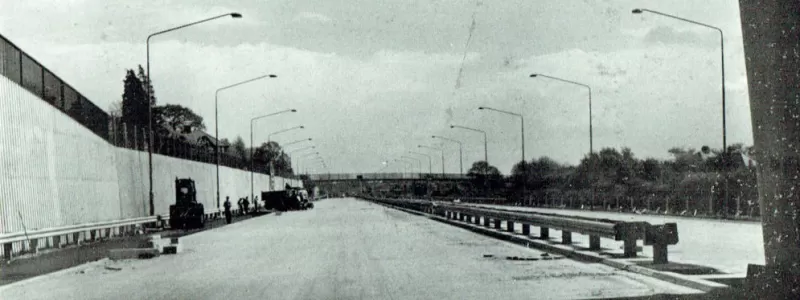Welcome to the London of the late 1960s - a London where anything seemed possible. Including, perhaps remarkably, the idea that carving new motorways through residential areas might be a good idea.
Not many urban motorways were ever built in London, of course - plans to build a huge network of them across the city were derailed before they really got going, as described in our extensive Ringways pages. But some were built and they're still with us today.
We've been building up a collection of interesting and unusual opening booklets for years now - the little commemorative pamphlets that used to be published to accompany the opening ceremony for a new section of road. Some show interesting future plans that never came to light, others have diagrams showing the ingenuity with which those roads were designed and built. Most of them have brilliant photographs of brand-new roads that you won't find anywhere else. Now we're very pleased to be adding two new ones, and possibly two of the best so far, to our collection.
One is for the Western Avenue Extension - the road better known by its official name, the Westway, and indeed the road that played a big part in turning public opinion against motorway building in London. The booklet that was published for its opening ceremony was created by the Concrete and Cement Association, an industry body that was understandably very proud of the role that concrete had played in the building of a major new elevated road. Inside the booklet there are wonderful artists' impressions of the new road, engineering plans detailed enough to give you a decent head start if you want to build your own Westway, and descriptions of the future motorway system that London will enjoy in the decades to come.
What it doesn't feature - in any of the plans, descriptions or even really in the artists' impressions - is any sense that the new road was shoved in the most damaging way through residential areas, and that it came at the expense of the peace and happiness of an awful lot of people. But then that sort of thing doesn't ever feature in these breathlessly optimistic publications, and was not likely to have been the focus of an organisation whose business was promoting concrete as a construction material.
Ruthlessly shoved through another residential area was the M1 Hendon Urban Motorway, the subject of the other new booklet. This bit of urban roadbuilding is often overlooked today, but bringing the M1 south through Mill Hill and Hendon to reach the North Circular involved cutting a path alongside the Midland Main Line railway through established suburbia. The casual and relaxed way this is discussed in the scheme's accompanying booklet is, to modern eyes, quite astonishing.
Make your way through the text describing the achievements of the road's engineers ("composite action is induced by horseshoe shear connectors welded to the steel beams prior to preflection which, incidentally, reduces the possibility of brittle fracture") and the exhaustive list of everything they used to build it (132 rubber bearing pads) and you'll find a large selection of pictures of the roadworks and the completed motorway. For reasons I am unable to explain, a previous owner of the booklet has drawn their own streetlights in blue biro on one or two of them.
We'll continue bringing you more of these ever-popular publications as we get our hands on them, but right now, the Western Avenue Extension and the M1 Hendon Urban Motorway opening booklets are online for you to feast your eyes.
Elsewhere on
Roads.org.uk...
Opening booklets
In days gone by, new roads were often celebrated with a grand opening ceremony and the issue of a commemorative booklet heralding the exciting new highway. You'll find some of them here, complete with a glimpse of all that empty tarmac and a healthy dose of modernist optimism.
Pedantry corner: yes, we know the Westway was opened in 1970, but it was designed and largely built in the 1960s. Call it poetic licence.
Add new comment
Picture credits
- Title picture is taken from the "Western Avenue Extension" booklet, published by the Concrete and Cement Association and believed to be out of copyright.


